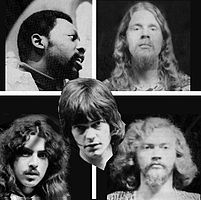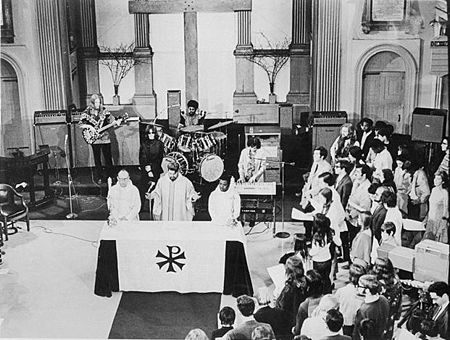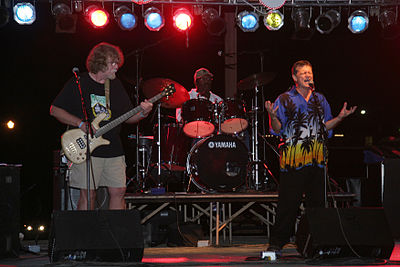- Mind Garage
-
MIND GARAGE
Top Row L-R Ted Smith, Norris Lytton
Bottom Jack Bond, John Vaughan
Center Larry McClurg,
.Background information Origin Morgantown, West Virginia, United States Genres Psychedelic rock
Hard rock
Progressive rock
Acid rock
Christian rockYears active 1967–1970
(Reunions: 1983, 2007, 2008)Labels RCA
Morning Glori MusicAssociated acts Glass Menagerie, Esquires, Epics, Spiders, Royals
Shadows of Knight
SpinnersWebsite www.mindgarage.com Members Original and Current Members
Larry McClurg - Norris Lytton
Jack Bond - John Vaughan
Ted SmithInstruments Shure Mics & Traynor PA equipment
Premier custom chrome drums : double basses
1966 Hagstrom Bass & Ampeg amplifier
Hammond B-3 & Leslie cabinet model 147
Gibson Firebird guitar & Soundlab ampPast members Members of Glass Menagerie
John Fisher - Norris Lytton
Tony Senator - Harry Fuller
Tom Warfield - Jim Straub
Larry McClurg - Jack BondMind Garage was an American psychedelic rock and roll band from Morgantown, West Virginia, and a progenitor of Christian rock music. Their "Electric Liturgy" performed in 1968 was the first documented Christian rock worship service, and their 1969 eponymous debut RCA album was one of the earliest Christian rock albums released.
Contents
History
Formation
Mind Garage was formed after a five person band from Morgantown, West Virginia called the Glass Menagerie disbanded in July 1967 after touring the Midwest. Those leaving the Glass Menagerie were John Fisher, lead guitarist, who joined the Shadows of Knight as a bass player; and Jim Straub, the drummer. The remaining three members, Larry McClurg, Jack Bond, and Norris Lytton returned to Morgantown where they were all students at West Virginia University. After meeting two other WVU students John Vaughan and Ted Smith, it was decided to form a new band. The band was encouraged by WVU's campus minister, Episcopal priest Rev. Michael Paine, who helped the group to organize its religious repertory,[1] while Paine's wife, Victoria "Tori" Paine, suggested the name Mind Garage to the band.[2]
The Electric Liturgy
In 1967 Paine suggested the band write rock music with Christian content for use in the church, following the tradition of Bach who used popular tavern songs in his music. "At that time, there were virtually no albums available to a national audience that could remotely be described as Christian rock; it's impossible to overstate how radical the "Electric Liturgy" was in that context.[3] The Mind Garage, which never limited itself to one style of music began composing the Electric Liturgy[4] in Paine's attic with a serious intent[5] to get the message across. The Electric Liturgy was conceived as an orthodox Episcopalian service, but was immediately transformed into an inter-denominational service by the people themselves. It was not uncommon to witness Episcopalians, Catholics, Protestants and Jews together, all taking Communion. People who were out of religion found a meaning in the music.[6]
The live presentation of the Electric Liturgy contains the Kyrie Eleison and The Service of the Word (Greeting, Opening Prayer, First Reading, Psalm, Epistle Reading, Gospel Reading, Sermon, Creed, Pastoral Prayer and the Offertory), immediately followed by the Service of Communion which concludes with a prayer and Benediction and the dismissal of the congregation. The church programs explained that "the Holy Communion is the Creator's act through His people of binding the wounds and healing a broken humanity. Sometimes it is a party, sometimes not. But participation in it signals your desire to take on hope. Therefore all people confessing their frail humanity and yearning for a greater are welcome to come to the altar and receive Holy Communion."[7]
This is the same format used by "Presbyterian, Methodist, and Episcopal service books, historic liturgies from the Catholic Church and the Antiochian Orthodox Christian Church, and ancient liturgies from Egypt, Mesopotamia, and Cappadocia...which all have the same basic structure."[8]
On March 10, 1968, in the first documented Christian rock worship service, the Mind Garage played live in church, "...as cymbals crashed and voices called for love and thanksgiving, babies squealed and happy smiles spontaneously flickered across the congregation".[9] As a result, "those dirty, beatnick-hippies began to have a new image. 'I didn't know they were like THAT,' one woman exclaimed, "That was beautiful!"
The April 14, 1968 Easter Sunday performance originally scheduled on West Virginia University property was cancelled when university administrators backed out of the previous arrangement with Paine and declared the performance unconstitutional. Paine then bargained with the First Presbyterian church to use their parking lot. In the mounting tension the church elders refused to allow the band to use the church facilities when the local paper ran a photo of the Mind Garage in a tree with Paine and friends standing about. At the last moment Rev. Jennings Fast of Wesley Methodist Church provided a place for the service.
The Electric Liturgy became so popular the band was invited to perform the worship service in churches throughout the Eastern United States including Washington, D.C., New York, and Princeton University Chapel. The Electric Liturgy was shocking. Dean Ernest Gordon of Princeton University said, "We could all do with a shocking splendid spiritual surprise."[10]
On July 24, 1968, the term "theo-rock" was coined in the Village Voice in reference to The Mind Garage music.[11] By the end of 1968, the Mind Garage had performed the "Electric Liturgy" live more than a dozen times, in Episcopal, Catholic, Presbyterian, Baptist and Methodist churches, each time with people dancing in the aisles. Each time the services were attended by Christians and non Christians alike in a communal celebration of life. The Mind Garage "literally packed the church". What they did was "...to contemporize religious music. Make it for people today, much as John Wesley or Martin Luther did.[12]
A nationally televised Christian Rock and Roll worship service was given by the Mind Garage in St. Mark's Episcopal church in New York on ABC TV, on April 13, 1969.[13]
The Electric Liturgy, recorded for RCA Victor (LSP-4319) in 1969 was the first Christian Rock album ever recorded in Nashville, at RCA's "Nashville Sound" Studio A, on Music Row.
An award-winning article by Joyce Tracewell[14] describes the Electric Mass: "Sun shines through stained glass and colors bounce until the kaleidoscopic vision is suddenly shattered by incredibly swelling music. Smiling musicians with flowery clothes, jeans, long hair, beards and sunglasses play deliberate alien music, the kind that makes you shiver. It fills the room to the ceiling pushing against the walls. They sing in voices that should have belonged to Druids or Incas, or Gypsies under a night sky, and you see Jesus smiling at them. When you leave you feel somebody has been dissecting your soul and everything is clearer. And that's what an Electric Mass is."
One poster associated with the Mind Garage[15] is a line drawing of a bare chested woman with long flowing hair that nearly covers the chest, with her arms raised, surrounded by the group. It was used several times as the cover for service booklets, most notably in St. Mark's Episcopal Church in the Bowery, New York City. An adaptation was created for the Electric Liturgy by covering the woman's chest with a banner displaying the words "We Welcome You To The Electric Liturgy, A Festival of Feeling, The Electric Mass".[16]
Recording career
While still known only locally, the Mind Garage recorded an original single 45 rpm "Asphalt Mother", and drew the attention of major record companies like Chess Records, Atlantic Records and RCA. Marshall Chess came to see the band expecting to hear blues and went away baffled as to the kind of music they played. Atlantic Records only wanted to sign McClurg, but he refused to leave the band. Meanwhile, the Mind Garage continued to play the Electric Mass in church services for free wherever asked, while at the same time shocking and entertaining the audiences in clubs, concert halls and stadiums with their own style of secular, psychedelic rock.
In 1969 the group's newly acquired manager, Tom Surman, aka Cossie, negotiated a contract for the entire band with RCA, the largest record company in the world. The Mind Garage recorded two albums and two singles in New York, Chicago and Nashville studios.
Armed Forces Radio and Television Service entertained troops at home and abroad in Vietnam with the music of the Mind Garage and other artists such as Gary Lewis, Bob Seger, and Percy Faith. The Mind Garage often appeared with groups such as Canned Heat, Sly and the Family Stone, Paul Butterfield, all of whom played at Woodstock 1969.[17]
Hiatus
The Mind Garage declined the invitation to perform at Woodstock in 1969.[18]
In 1970, when their recording contract was about to expire, RCA offered to renew it but the band declined.[19] Without explanation they walked away from a recording career, and simply stopped playing. The band never officially broke up. There was no press release, and no dispute among members, or management. Drummer Ted Smith, acknowledged by the Zildjian cymbals as one of the best drummers in the world,[20] continued his career with the Spinners as tour drummer for the next several decades, and can be heard on the Spinners "LIVE" album (Atlantic SD 2-910-1198).
Reunion
In 2007 all five original band members reunited for a music festival. The Father of Woodstock Artie Kornfeld teamed up with Larry McClurg to promote Goodstock Music Festival, reported Pollstar.
According to Kornfeld,[21] "I consider Goodstock to be the first real attempt to have another 3 days of peace and music". "When everybody's doing Woodstocks in 2009, I'm going to be doing Goodstock -The Woodstock Reunion 2009, and that's my dream for Larry and I to have."
Composite Concert Review
A Mind Garage concert was often billed a celebration of life,[22] a total electric happening. Graffiti Magazine reported, "their musicianship was stunning and their stage presence was natural and unpretentious."
But a Garage performance could be so much more. People would not only be stunned by the musicianship, but they would experience shock.[23] It was then that they would be overcome by the band's sincerity and superb musicianship. They were able to draw people into what they were doing.[24] The intent was to involve all the senses. The band had the power to transform[25] the places they played in and the people they played for with a primal heartbeat rhythm,[26] an exacting, instrumental harmony[27] and a rising pitch that reflected or drove the intensity of the audience. The visual theatrics seem to invoke "the forces of nature to come crashing down," reported Hit Parader Magazine.[28] Then they would play soft familiar passages to bring the listener back to earth.
Mind Garage was not the usual frat party or sock hop band of that period. They took over with mind blowing techniques.[29] Hours before the show, people would arrive to get a good seat only to find a crowd already there. People would push and shove to get in until the doors finally burst open. The entire street would fill up and police would give up trying to keep some sense of order and took to re-routing traffic. Sites would pack beyond capacity at many of the venues with people swelling out the doorways.[30] Getting in the door insured the participant some form of entertainment. In the Fairmont Theatre lobby, someone was seen in a tub taking a bath. Nothing ever seemed to be routine at these engagements.
On occasion there were other performers, light shows, bizarre, psychic, fashion shows and dancers, but the Mind Garage was always the central focus. General comment from rockers would float around in conversations while the band was on break. It usually would be summed up in the only way they knew how to express it, "Man, these guys are f---ing good!"
The Mind Garage not only had the right sound but they had, it seemed, much more - a spiritual spark, a magnetic charisma, a mesmerizing magic. It moved cynic; it moved saint. Mind Garage would become the proto-Christian music rock band for the wave of Jesus music that would follow them.
Significance
Christian rock music did not exist in 1967 for mainstream American media. As alternative styles of music developed "...Christian Rock Music began in the 1970s when a group known as the Mind Garage recorded "Electric Liturgy".[31] The Mind Garage is perhaps the first Christian Rock band,[32] with documentation going back to 1967 in local media and national magazines and newspapers and television such as The Village Voice,[11] Billboard and Rolling Stone magazine,[33] ABC and NBC TV.[34] "Today original records from many of the original Jesus Rock bands like The Mind Garage (arguably the first band of its kind), Aslan, Selah, The Concrete Rubber Band, and Agape go for hundreds of dollars to collectors...".[35]
For as little time as the Mind Garage performed, their original, unique style and energy had a ripple effect that reached the Punk era and New Wave music and beyond. The late 1970s group The Fleshtones refer to the Mind Garage as an influence.[36] Noted folk rock musician John Denver acknowledged each member of the Mind Garage for contributing to his 1982 Gold album "Seasons of the Heart".[37]
Members
- Larry McClurg - lead vocals
- Norris Lytton - vocals, bass and sax
- Ted Smith - percussion
- Jack Bond - vocals, keyboard
- John Vaughan - vocals, lead guitar
Discography
- "Asphalt Mother"/"Reach Out" - Morning Glori Music 45RPM 1000 - 1968
- Mind Garage - RCA VICTOR Stereo LSP-4218 Album - 1969
- "What's Behind Those Eyes"/ There Was a Time" - RCA Victor 45RPM 47-9755 - 1969
- Mind Garage Again (w/Electric Liturgy) - RCA Victor Stereo Album LSP-4319-1970
- "Tobacco Road"/ "Jailhouse Rock" - RCA Victor 45RPM 47-9812 - 1970
- Mind Garage Lost Demo Early Years CD - Morning Glori Music 2000 - 2005
- Mind Garage /and Mind Garage Again! Compilation CD - Caustic Eye Productions CAUS017 - 2007
- Mind Garage: A Total Electric Happening - European Release on Anazitisi Records 2009
- Mind Garage Five Yellow Sun Music 2010
See also
References
- ^ The Living Church, Vol. 157 (Morehouse-Gorham Co., 1968):70.
- ^ About Mind Garage
- ^ Fathermosh (2004-02-29). "Father Mosh Fix It in the Mix". Fixitinthemix.blogspot.com. http://fixitinthemix.blogspot.com/2009_04_01_archive.html. Retrieved 2011-09-18.
- ^ "Electric Liturgy Video". Youtube.com. http://www.youtube.com/watch?v=klmhgRRRnHM. Retrieved 2011-09-18.
- ^ Daily Atheneum WVU Student Newspaper (April 15, 1968) [1]
- ^ [2] Dominion News January 23, 1970]
- ^ "Holy Communion". Mindgarage.com. 1968-07-24. http://www.mindgarage.com/voice.html. Retrieved 2011-11-16.
- ^ "Rev. Ken Collins The Service of the Word". Kencollins.com. http://www.kencollins.com/pray-30.htm. Retrieved 2011-09-18.
- ^ "Documented Christian Rock Worship with Live Band in Church" (March 10, 1968)[3]
- ^ [4] "Splendid Shocking Spiritual Surprise Princeton University" (May 26, 1968).]
- ^ a b [5] Village Voice - Riffs July 24, 1968]
- ^ "Dominion News January 23, 1970". Mindgarage.com. 1970-01-25. http://www.mindgarage.com/alastmass.html. Retrieved 2011-09-18.
- ^ [6] Nationally Televised Christian Rock Worship Service April 13, 1969]
- ^ Winner of Best Feature Story Award of 1969 by American Newspaper Association and Quill and Scroll [7]
- ^ [8] Mind Garage Poster]
- ^ [9] We Welcome You To the Electric Liturgy Poster]
- ^ [10] Woodstock 1969 Lineup - Declined Invitations]
- ^ [11] Woodstock 1969 Lineup - Declined Invitations]
- ^ "RCA to Renew Mind Garage Recording Contract". Mindgarage.com. http://www.mindgarage.com/noguitar.html. Retrieved 2011-09-18.
- ^ "Perfect Sound Magazine December 2006". Furious.com. http://www.furious.com/perfect/mindgarage.html. Retrieved 2011-09-18.
- ^ "Artie Kornfeld Interview". Goodstock2007.com. 2008-06-15. http://www.goodstock2007.com/kornfeld.rss. Retrieved 2011-09-18.
- ^ [12] Celebration of Life]
- ^ [13] Shocked and Amazed Parkersburg News April 18, 1970]
- ^ George Cornell Religion Religion Writer for the Associated Press January 28, 1968 [14]]
- ^ Power to Transform Rat Subterranean News February 7, 1970 [15]
- ^ Jerry Bowles Sound and Fury WV Student Newspaper Daily Athenaeum April 16, 1968 [16]]
- ^ John Corey Electric Liturgy WV Student Newspaper Daily Athenaeum March 19, 1968 [17]]
- ^ [18] Hit Parader September 1970]
- ^ [19] National Liturgical Conference August 19–22, 1968]
- ^ [20] Standing in the Isles Swelling out the Doorways]
- ^ The Politics of Values: Games Political Strategists Play, Jo Renee Formicola, Published by Rowman & Littlefield 2008 Page 64
- ^ Archer, Bill. "Bluefield Daily Telegraph April 24, 2009". Bdtonline.com. http://www.bdtonline.com/columns/local_story_114164933.html. Retrieved 2011-09-18.
- ^ Mind Garage - Rolling Stone Magazine August 6, 1970 Page 25[dead link]
- ^ "Record World August 16, 1969". Mindgarage.com. http://www.mindgarage.com/wallst.html. Retrieved 2011-09-18.
- ^ Brian Collins, Sightings, Martin Marty Center University of Chicago Divinity School. [21]
- ^ Mind Garage Influence in Punk Era 1977
- ^ "Mind Garage Contributes to John Denver Gold Album 1982". Softshoe-slim.com. http://www.softshoe-slim.com/lists/d/denver.html#21. Retrieved 2011-09-18.
External links
Categories:- American progressive rock music groups
- Christian rock groups from West Virginia
- Psychedelic musical groups
Wikimedia Foundation. 2010.



